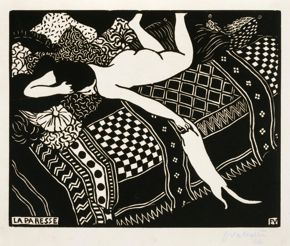Intimate Settings and Public Spaces: Impressionist and Post-Impressionist Drawings and Prints November 11, 2010–January 17, 2011

Félix Emile-Jean Vallotton, Laziness (La Paresse), 1896, woodcut.
Edouard Vuillard, The Avenue (L’Avenue), 1899, lithograph in colors.
Pierre Bonnard, La Petite Blanchisseuse (The Little Laundry Girl), 1895–96, lithograph in colors on wove China paper, the Museum of Fine Arts, Houston, Museum purchase in memory of Virginia Jackson, funded by the Alvin S. Romansky Prints and Drawings Accessions Endowment Fund, the Marjorie G. and Evan C. Horning Print Fund, members of the Prints and Drawings subcommittee, and friends of Virginia Jackson.
Henri de Toulouse-Lautrec, Moulin Rouge, 1891, lithographic poster printed in color on paper (first state of two)
Edgar Degas, The Russian Dancer, 1895, pastel and charcoal on joined paper laid down on board.
Mary Cassatt, Under the Horse-Chestnut Tree, 1896–97, drypoint and aquatint on laid paper, the Museum of Fine Arts, Houston, Museum purchase funded by The Brown Foundation, Inc.
"MFAH Impressionist drawings evoke Paris in a new age of urban culture" —CultureMap.com
Born into a new age of urban culture, social mobility, and leisure,
the Impressionists captured the era's rampant prosperity and social change in images of places they inhabited. This exhibition of some
60 works on paper looks at those spaces—both public and private—and the various artistic methods the artists used to captivate their modern world.
The public spaces range from fashionable boulevards, avenues, and parks to café concerts, theaters, bars, and racetracks. While they looked at their changing world, the Impressionists also turned inward for inspiration, utilizing friends and family as models set within their immediate surroundings. Glimpses of intimate settings reveal daily domestic pastimes: housework and childcare, bedrooms and boudoirs, entertaining and etiquette.
The Post-Impressionist artists, working mainly from the 1880s onward, continued to draw from the same subject matter as the Impressionists but developed different precepts for the use of color, pattern, form, and line. Intimate Settings and Public Spaces: Impressionist and Post-Impressionist Drawings and Prints features work by artists including Pierre Bonnard, Mary Cassatt, Jules Chéret, Edgar Degas, Édouard Manet, Auguste Renoir, Henri de Toulouse-Lautrec, Félix Emile-Jean Vallotton, and Édouard Vuillard.
Paintings have been of primary use in the discussion on Impressionist and Post-Impressionist imagery, based on the interest in visible brush strokes and emphasis on light and color. Yet works on paper—using
a diversity of media from chalk, graphite, pastel, and watercolor to etchings and lithographs—also demonstrate both groups' interest in capturing private and public spaces.
This exhibition is organized by the MFAH.
Generous funding is provided by:
Dr. Ira J. Jackson
Mr. and Mrs. Michael C. Linn
